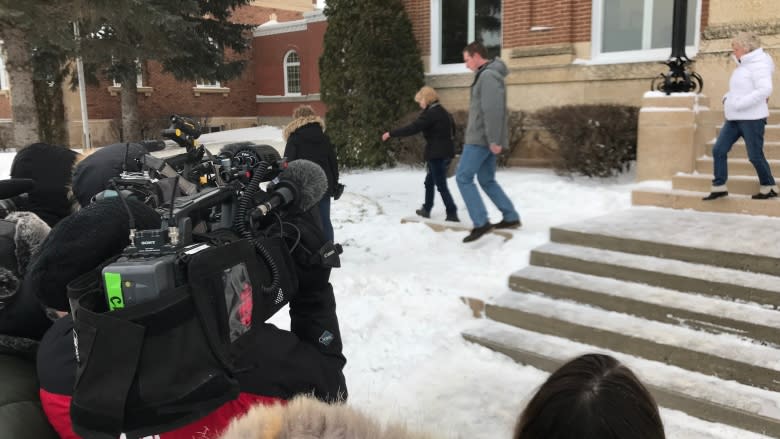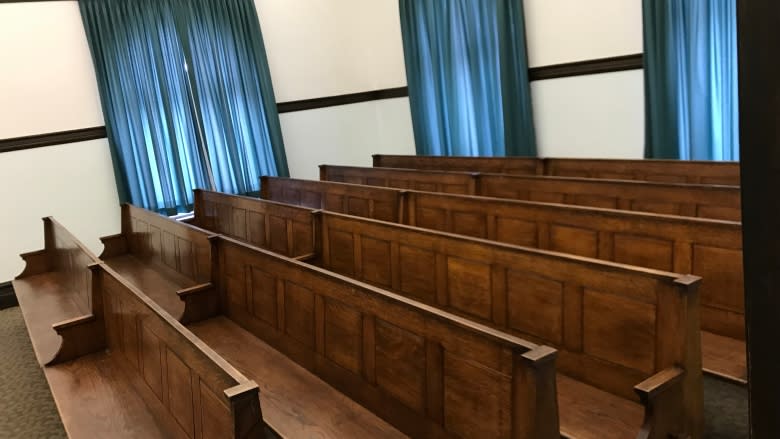Gerald Stanley murder trial was 'not the right case' for cameras in the courtroom: judge
Cameras are rarely allowed in Canadian courtrooms, but the Gerald Stanley murder trial could have been an exception.
Stanley, a 56-year-old farmer, was charged with second-degree murder in the shooting death of Colten Boushie, a 22-year-old man from the Red Pheasant Cree Nation.
The Saskatchewan case had highlighted the friction between Indigenous and non-Indigenous people in the province, between rural and urban. Some saw it as a test case for the wider issues of racism and justice.
Which is why a group of media outlets applied to broadcast or live stream parts of the trial, arguing it had "major social and justice interest and importance."
But the defence lawyer in the case expressed concern over it becoming a "spectacle" and asked that the application be denied — and the judge overseeing the trial agreed.
"This is not the right case to put in a petri dish for experimental purposes," ruled Chief Justice of Saskatchewan's Court of Queen's Bench, Martel Popescul. He said allowing the cameras in would be a "marked departure" from the norm.
Jurors would have been out of view
The application, filed jointly by CBC News, Global News, CTV, Postmedia Network and Aboriginal Peoples Television Network, called for three fixed cameras to record, broadcast and live stream specific portions of the trial, including Popescul's opening remarks to the Crown and defence opening and closing arguments to the verdict.
None of the jurors or witnesses would have been captured on camera.
No camera operators would have been in the courtroom, and Popescul would have had a kill switch at his side to stop the transmission whenever he wanted.
The Boushie family supported the plan.
CBC News wanted to broadcast parts of the trial because of the case's "major social and justice interest and importance for the citizens of Saskatchewan," according to the affidavit.
"I believe [we] will play a key role in informing the public about the process and the proceedings," wrote David Hutton, managing editor of CBC Saskatchewan.
Defence feared 'spectacle'
Stanley's defence lawyer, Scott Spencer, in a brief arguing against the application, acknowledged it would help the case reach a larger audience, but said doing so would turn "this trial into a spectacle for entertainment purposes."
The trial did, indeed, have many emotional moments, particularly after the "not guilty" verdict was read. There were anguished outbursts from people seated in the small gallery, and the ensuing fury was such that a sheriff's deputy had to rush Stanley out of the room, with the jury quickly following suit.
Spencer had also objected to the idea of only showing parts of the trial.
"The court's function is one of truth-finding and inquiry," he wrote. "By broadcasting only select portions of the argument, the media will not be providing insight into how that function is accomplished."
While both Popescul and Spencer argued that the courtroom was open to anyone who wanted to attend in person, CBC Saskatchewan's Hutton said that jobs and family obligations, not to mention geographic distance, made that unlikely for most people.
What coverage was available?
In the absence of cameras, CBC News reporters live-tweeted a moment-by-moment account of each day of the trial, except for parts when the jury wasn't present.
CBC News also commissioned Regina-based artist Cloudesley Rook-Hobbs to produce illustrations of Popescul, Stanley, the lawyers and the witnesses.
But the judge's camera ban didn't stop all video footage from getting out.
A public overflow room on the ground floor of the Battleford courthouse was equipped with two TVs offering simultaneous views of Popescul, the lawyers, the witness box and the jury and gallery behind it.
Someone in the overflow room posted a video of the verdict on Facebook on Friday, but it was taken down Monday after the province's Ministry of Justice expressed "grave concern," particularly about the possibility of jurors being identified.
Bill Johnson, the lawyer representing CBC News in its application, said that incident brought home why broadcasting the Stanley trial could have made a difference.
"This [Facebook video] occurred because a picture is worth a thousand words and is a crucial aspect of citizens' freedom of expression in public settings," Johnson said. "Our application would have secured juror privacy and told that verdict part without interfering in any way with Gerald Stanley's right to a fair trial."
'Limited access would have been appropriate'
"I think there's a lot of news that is broadcast that is disturbing and troublesome to people — we can't hide from the truth," said Kristian Bonn, a trial lawyer in Belleville, Ont., whose firm practises criminal defence and civil litigation.
Bonn wrote a blog postabout broadcasting trials last fall, after a judge decided to allow cameras inside the Alberta courtroom where the verdict for the Travis Vader murder trial was delivered.
Bonn said he doesn't support entire trials being broadcast or streamed live, but said there's no reason the Stanley verdict could not have been available in real time to people outside the Battleford courthouse.
"The evidence had been done, the jury had made its decision, and there's no harm at that point in time of any juror members being trained or any witnesses playing to the camera," he said.
"A limited access would have been appropriate in these types of cases which attract national attention."
Popescul declined to comment about his ruling.



